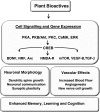Flavonoids and brain health: multiple effects underpinned by common mechanisms
- PMID: 19685255
- PMCID: PMC2775888
- DOI: 10.1007/s12263-009-0136-3
Flavonoids and brain health: multiple effects underpinned by common mechanisms
Abstract
The neuroprotective actions of dietary flavonoids involve a number of effects within the brain, including a potential to protect neurons against injury induced by neurotoxins, an ability to suppress neuroinflammation, and the potential to promote memory, learning and cognitive function. This multiplicity of effects appears to be underpinned by two processes. Firstly, they interact with important neuronal signalling cascades leading to an inhibition of apoptosis triggered by neurotoxic species and to a promotion of neuronal survival and differentiation. These interactions include selective actions on a number of protein kinase and lipid kinase signalling cascades, most notably the PI3K/Akt and MAP kinase pathways which regulate pro-survival transcription factors and gene expression. Secondly, they induce peripheral and cerebral vascular blood flow in a manner which may lead to the induction of angiogenesis, and new nerve cell growth in the hippocampus. Therefore, the consumption of flavonoid-rich foods, such as berries and cocoa, throughout life holds a potential to limit the neurodegeneration associated with a variety of neurological disorders and to prevent or reverse normal or abnormal deteriorations in cognitive performance.
Figures



References
-
- {'text': '', 'ref_index': 1, 'ids': [{'type': 'DOI', 'value': '10.1002/jhbs.1094', 'is_inner': False, 'url': 'https://doi.org/10.1002/jhbs.1094'}, {'type': 'PubMed', 'value': '11835218', 'is_inner': True, 'url': 'https://pubmed.ncbi.nlm.nih.gov/11835218/'}]}
- Abraham TH (2002) (Physio)logical circuits: the intellectual origins of the McCulloch-Pitts neural networks. J Hist Behav Sci 38:3–25 - PubMed
-
- {'text': '', 'ref_index': 1, 'ids': [{'type': 'DOI', 'value': '10.1016/S0160-9327(03)00017-6', 'is_inner': False, 'url': 'https://doi.org/10.1016/s0160-9327(03)00017-6'}, {'type': 'PubMed', 'value': '12642144', 'is_inner': True, 'url': 'https://pubmed.ncbi.nlm.nih.gov/12642144/'}]}
- Abraham TH (2003) Integrating mind and brain: Warren S. McCulloch, cerebral localization, and experimental epistemology. Endeavour 27:32–36 - PubMed
-
- {'text': '', 'ref_index': 1, 'ids': [{'type': 'DOI', 'value': '10.2217/17460875.2.4.403', 'is_inner': False, 'url': 'https://doi.org/10.2217/17460875.2.4.403'}, {'type': 'PMC', 'value': 'PMC2174836', 'is_inner': False, 'url': 'https://pmc.ncbi.nlm.nih.gov/articles/PMC2174836/'}, {'type': 'PubMed', 'value': '18176634', 'is_inner': True, 'url': 'https://pubmed.ncbi.nlm.nih.gov/18176634/'}]}
- Adibhatla RM, Hatcher JF (2007) Role of lipids in brain injury and diseases. Future Lipidol 2:403–422 - PMC - PubMed
-
- {'text': '', 'ref_index': 1, 'ids': [{'type': 'DOI', 'value': '10.1038/sj.onc.1206206', 'is_inner': False, 'url': 'https://doi.org/10.1038/sj.onc.1206206'}, {'type': 'PubMed', 'value': '12592390', 'is_inner': True, 'url': 'https://pubmed.ncbi.nlm.nih.gov/12592390/'}]}
- Afaq F, Adhami VM, Ahmad N, Mukhtar H (2003) Inhibition of ultraviolet B-mediated activation of nuclear factor kappaB in normal human epidermal keratinocytes by green tea Constituent (−)-epigallocatechin-3-gallate. Oncogene 22:1035–1044 - PubMed
-
- {'text': '', 'ref_index': 1, 'ids': [{'type': 'DOI', 'value': '10.1016/S1471-4914(03)00020-0', 'is_inner': False, 'url': 'https://doi.org/10.1016/s1471-4914(03)00020-0'}, {'type': 'PubMed', 'value': '12657434', 'is_inner': True, 'url': 'https://pubmed.ncbi.nlm.nih.gov/12657434/'}]}
- Barzilai A, Melamed E (2003) Molecular mechanisms of selective dopaminergic neuronal death in Parkinson’s disease. Trends Mol Med 9:126–132 - PubMed
Grants and funding
LinkOut - more resources
Full Text Sources
Other Literature Sources
